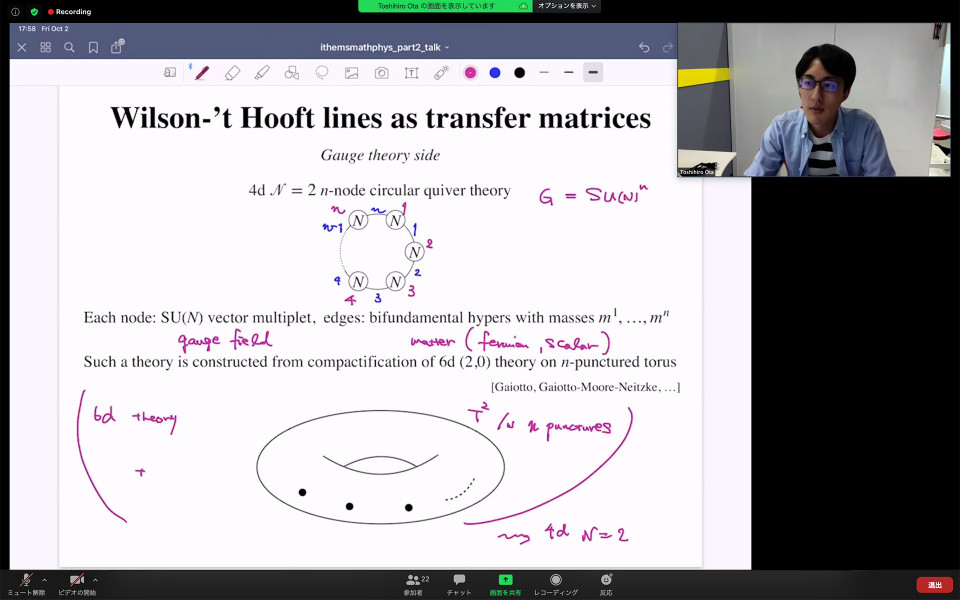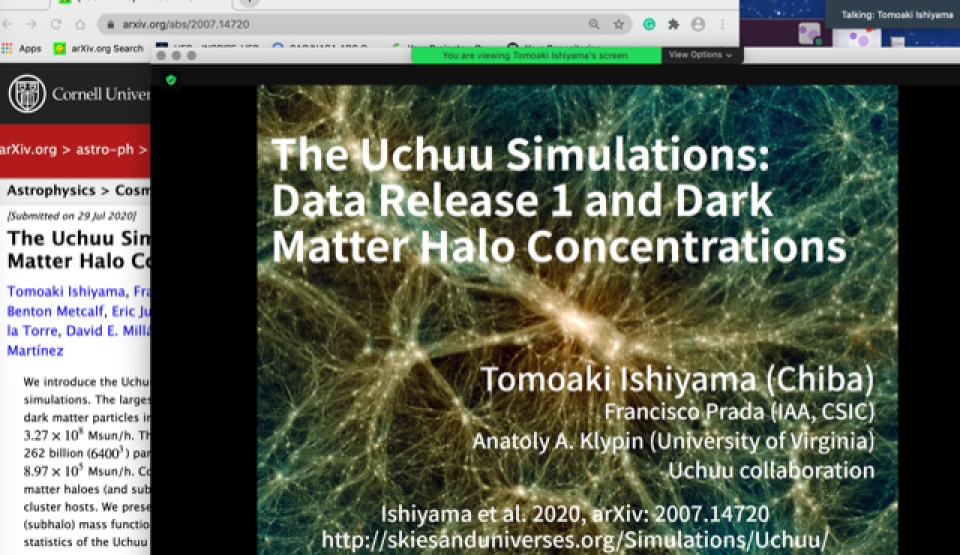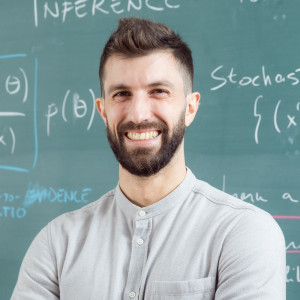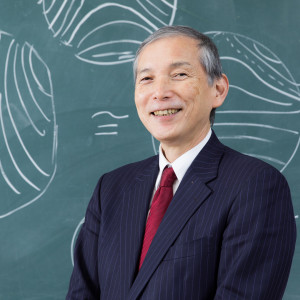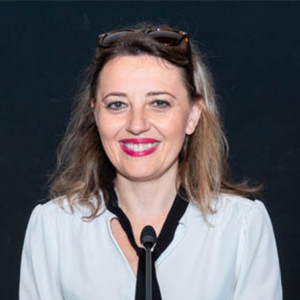Volume 123
Back to Newsletter List
Seminar Report
Math-Phys Joint Seminar by Toshihiro Ota on October 2, 2020
2020-10-07
On October 2, Toshihiro Ota gave a talk at the iTHEMS Math-Phys Joint Seminar. His whole talk was on the interrelation among integrable lattIce models, quiver gauge theories, and hidden TQFT structure.
His first talk was a sort of lecture on TQFT and integrable lattice model at an elementary level. At the beginning of the first talk, he explained quantum mechanics (QM). Then as a variant of QM, he introduced an axiomatic definition of topological quantum field theory as a special class of quantum field theory. He also introduced lattice model which can be seen as a discrete version of quantum field theories. In particular, he mentioned the integrability of the 1-dimensional Ising model.
In the second talk, he focused on the correspondence between Wilson-'t Hooft lines in a class of quantum gauge theories and transfer matrices in the corresponding integrable lattice models. At first, he gave an explanation of “classical integrability” and “quantum integrability” for field theories. In the case of 2-dimensional lattice model, he explained that the integrability is described by the Yang-Baxter equation. Then he moved on to the details of the correspondence. In the lattice model side of the correspondence, he described the transfer matrix in terms of n-copies of L-operators. Moreover, in order to compare to the gauge theory side, he took the trigonometric limit and rewrote the transfer matrix by “more fundamental” L-operators. The gauge theory side is in particular given by 4d N=2 n-node circular quiver theory. The theory is defined on a 4d twisted spacetime S^1 xε R^2 x R, and he gave an expression of the Wilson-'t Hooft line wrapping the circle S^1. As the main result of his joint work with Kazunobu Maruyoshi and Junya Yagi, he gave a relation between these Wilson-’t Hooft lines and transfer matrices. Finally, he gave several comments related to integrability from TQFT in extra dimension.
TQFT, integrable lattice model, and quiver gauge theories
October 2 (Fri) 16:00 - 18:00, 2020
Seminar Report
DMWG seminar by Dr. Ishiyama: a spectacular cosmological N-body simulation
2020-10-02
Visible components of our Universe, such as galaxies, show hierarchical structures. Such structures are always embedded in DM structures called "halos". In the early Universe, there exist small density fluctuations that eventually collapse to halos at some points by their self-gravity. Then, halos grow to form larger structures again by self-gravity and this is the origin of the structure of the current Universe. The large-scale structure of halos as well as their inner structures contain information about the nature of the DM particle.
Cosmological N-body simulation is a powerful computational method to follow that structure formation, by solving multi-body problems numerically. A halo, which is a clump of elementary DM particles, is treated as one smooth particle in N-body simulation. Its prediction power is so strong that the calculation corresponding to the upcoming cosmological survey, for example, has long been awaited. However, its computational costs scale as the square of the particle number N (or N log N when some reduction methods are adopted) and it is almost impossible to cover everything we need.
There are two strategies in the calculation: simulating a large volume with large particle mass, or a small volume with small particle mass. The former is suitable for studies that deal with the large-scale structure while the latter has advantages in studying the properties of each halo. His group has conducted a large high-resolution simulation project which enables us to study both of them. The Uchuu simulation, which uses the cubic of 12800 particles in a 2 Gpc-scale simulation box, enables us to study large-scale structures. The Shin-Uchuu simulation in the same project, which uses the cubic of 6400 particles in a 140 Mpc-scale box, is provided aiming to study the inner structure of DM halos. Analyzing the simulated structure and halo properties, the matter power spectrum covering from the largest to the non-linear regime is obtained. Also, the so-called mass-concentration relation in a wide halo mass range is now available thanks to the project. There is another good news for DM hunters: the results of the simulation are open to the public. This should boost the DM study from many aspects!
The Uchuu Simulations: Data Release 1 and Dark Matter Halo Concentrations
October 1 (Thu) 14:00 - 15:00, 2020
Announcement
JST/CRDS Seminar "Series of seminars on the collaboration of mathematics, science and ergonomics" Notice of Registration
2020-10-02
The Japan Science and Technology Agency (JST) is pleased to announce that it will hold a seminar titled "Series of Seminars on collaboration between Mathematics, Science and Engineering". There will be 16 sessions in total, covering topics ranging from machine learning to quantum computing, simulation, data science and many more. For more details, please refer to the related link.
Upcoming Events
Seminar
DMWG Seminar
Composite Dark matter and gravitational waves
October 20 (Tue) 10:00 - 11:00, 2020
Enrico Rinaldi (Visiting Scientist, RIKEN Interdisciplinary Theoretical and Mathematical Sciences Program (iTHEMS) / AI Researcher/Engineer, Arithmer Inc.)
With non-perturbative lattice calculations we investigate the finite-temperature confinement transition of a composite dark matter model. We focus on the regime in which this early-universe transition is first order and would generate a stochastic background of gravitational waves. Future searches for stochastic gravitational waves will provide a new way to discover or constrain composite dark matter, in addition to direct-detection and collider experiments. As a first step to enabling this phenomenology, we determine how heavy the dark fermions need to be in order to produce a first-order stealth dark matter confinement transition.
Venue: via Zoom
Event Official Language: English
Seminar
iTHEMS Biology Seminar
Bayesian nonparametric estimation of Random Dynamical Systems
October 21 (Wed) 14:00 - 15:00, 2020
Christos Merkatas (Postdoctoral Researcher, Aalto University, Finland)
In this talk, a Bayesian nonparametric framework for the estimation and prediction, from observed time series data, of discretized random dynamical systems is presented [1]. The size of the observed time series can be small and the additive noise may not be Gaussian distributed. We show that as the dynamical noise departs from normality, simple Markov Chain Monte Carlo method (MCMC) models are inefficient. The proposed models assume an unknown error process in the form of a countable mixture of zero mean normals, where a–priori the number of the countable normal components and their variances is unknown. Our method infers the number of unknown components and their variances, i.e., infers the density of the error process directly from the observed data. An extension for the joint estimation and prediction of multiple discrete time random dynamical systems based on multiple time-series observations contaminated by additive dynamical noise is presented [2]. In this case the model assumes an unknown joint error process with a pairwise dependence in the sense that to each pair of unknown dynamical error processes, we assign a– priori an independent Geometric Stick-Breaking process mixture of normals with zero mean. These mixtures a–posteriori will capture common characteristics, if there are any, among the pairs of noise processes. We show numerically that when the unknown error processes share common characteristics, it is possible under suitable prior specification to induce a borrowing of strength relationship among the dynamical error pairs. Then time-series with an inadequate sample size for an independent Bayesian reconstruction can benefit in terms of model estimation accuracy. Finally, possible directions for future research will be discussed.
References
- C. Merkatas, K. Kaloudis, and S. J. Hatjispyros, “A Bayesian nonparametric approach to reconstruction and prediction of random dynamical systems,” Chaos: An Interdisciplinary Journal of Nonlinear Science, vol. 27, no. 6, p. 063116, 2017.
- S. J. Hatjispyros and C. Merkatas, “Joint reconstruction and prediction of random dynamical systems under borrowing of strength,” Chaos: An Interdisciplinary Journal of Nonlinear Science, vol. 29, no. 2, p. 023121, 2019.
Venue: via Zoom
Event Official Language: English
Conference
Symposium in Commemoration of Professor Emeritus Shun'ichi Amari receiving the Order of Culture
October 21 (Wed) 13:00 - 18:00, 2020
A symposium will be held to commemorate Professor Emeritus Shun'ichi Amari (Graduate School of Engineering, The University of Tokyo) receiving the 2019 Order of Culture.
For more information and to book the event, please visit the Related Links (in Japanese).
Venue: via Online
Event Official Language: Japanese
External Event
Daikanyama College of Music Lecture Series Vol.1 - Music x Mathematics : May not music be described as the mathematics of the sense, mathematics as music of the reason?
October 21 (Wed) 20:00 - 21:00, 2020
Takashi Tsuboi (Deputy Program Director, RIKEN Interdisciplinary Theoretical and Mathematical Sciences Program (iTHEMS) / Professor, Musashino University)
Prof. Takashi Tsuboi, Deputy Program Director of iTHEMS will explain the beauty and harmony of Mathematics together with the piano performance by Rutsuko Yamagishi.
Venue: via Online
Event Official Language: Japanese
Seminar
iTHEMS Theoretical Physics Seminar
Realistic shell model and chiral three-body force
October 22 (Thu) 13:30 - 15:00, 2020
Tokuro Fukui (Researcher, Yukawa Institute for Theoretical Physics, Kyoto University)
We show an evolution to derive the effective Hamiltonian in the shell-model framework starting from two- and three-body interactions based on the chiral effective field theory. A new way to calculate three-body matrix elements of the chiral interaction with the nonlocal regulator is proposed.
We apply our framework to the p-shell nuclei and perform benchmark calculations to compare our results with those by an ab initio no-core shell-model. We report that our results are satisfactory and the contribution of the three-body force is essential to explain experimental low-lying spectra of the p-shell nuclei. We discuss the contribution of the three-body force on the effective single-particle energy extracted from the monopole interaction.
Next, we investigate the shell evolution on the pf-shell nuclei. We show that the monopole component of the shell-model effective Hamiltonian induced by the three-body force plays an essential role to account for the experimental shell evolution. Moreover, we present our latest results on the investigation of the possible neutron dripline of the Ca isotopes.
Finally, we discuss very neutron-rich systems, namely, the oxygen isotopes at the dripline and beyond, where the interplay between the three-body force and continuum states plays an important role.
If you would like to participate, please register using the form below.
Venue: via Zoom
Event Official Language: English
Seminar
iTHEMS Theoretical Physics Seminar
Toward simulating Superstring/M-theory on a Quantum Computer
October 23 (Fri) 17:00 - 18:00, 2020
Masanori Hanada (Department of Mathematics, University of Surrey, UK)
We present a framework for simulating superstring/M-theory on a quantum computer, based on holographic duality. Because holographicduality maps superstring/M-theory to quantum field theories (QFTs), we can study superstring/M-theory if we can put such QFTs on a quantum computer --- but it still looks like a complicated problem, if we use a usual lattice regularization. Here we propose an alternative approach, which turns out to be rather simple: we map the QFT problems to matrix models, especially the supersymmetric matrix models such as the Berenstein-Maldacena-Nastase (BMN) matrix model. Supersymmetric matrix models have natural applications to superstring/M-theory and gravitational physics, in an appropriate limit of parameters. Furthermore, for certain states in the Berenstein-Maldacena-Nastase (BMN) matrix model, several supersymmetric quantum field theories dual to superstring/M-theory can be realized on a quantum device. It is straightforward to put the matrix models on a quantum computer, because they are just quantum mechanics of matrices, and the construction of QFTs is mapped to the preparation of certain states. We show the procedures are conceptually rather simple and efficient quantum algorithms can be applied. In addition, as a (kind of) byproduct, we provide a new formulation of pure Yang-Mills on quantum computer.
If you would like to participate, please register using the form below.
Venue: via Zoom
Event Official Language: English
External Event
The Mathematical Society of Japan: Cross-discipline and cross-industry research exchange meeting 2020
October 31 (Sat) 10:00 - 17:00, 2020
For more information, please refer to the related links. (in Japanese)
Venue: via Online
Event Official Language: Japanese
Person of the Week
Self-introduction: Maria Giovanna Dainotti
2020-10-06
I am originally from a city in South of Italy. After my PhD at the University of Rome La Sapienza in 2008 I moved to Jagiellonian University in 2009 as a research assistant and I have been Visiting Scholar in several places all around the globe. I here mention a few: I was already at RIKEN with the JSPS Fellowship in November 2014-January 2015 in the ABBL group under the direction of Nagataki-san and as a visiting researcher in January and February 2019. I was in US at Stanford University with the Fulbright, Marie Curie’ and the American Astronomical Society Fellowship from 2012-2013, and 2015-2018. In all these years I have been studying Gamma-Ray Bursts, selection biases in treating GRB correlations, their application as cosmological tools and as a tool to discriminate among theoretical physical models. More recently I have started working on machine learning for redshift extraction of GRBs and Active Galactic Nuclei and on the selection effects in SNe cosmology in collaboration with Hatsuda-san and Nagataki-san. Last year I started collaborating with Don Warren and Gilles Ferrand to a project that aims to include virtual reality to show GRBs correlations to a broader audience.
Paper of the Week
Week 2 & 3 of October
2020-10-15
Title: Seiberg-Witten Floer homotopy contact invariant
Author: Nobuo Iida, Masaki Taniguchi
arXiv: http://arxiv.org/abs/2010.02132v1
Title: The groups of diffeomorphisms and homeomorphisms of 4-manifolds with boundary
Author: Hokuto Konno, Masaki Taniguchi
arXiv: http://arxiv.org/abs/2010.00340v1
Title: Global 3-group symmetry and 't Hooft anomalies in axion electrodynamics
Author: Yoshimasa Hidaka, Muneto Nitta, Ryo Yokokura
arXiv: http://arxiv.org/abs/2009.14368v1
If you would like to cancel your subscription or change your email address,
please let us know via our contact form.
Copyright © iTHEMS, RIKEN. All rights reserved.


